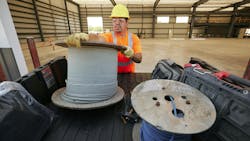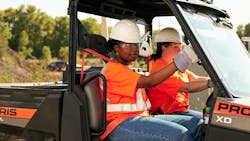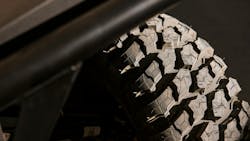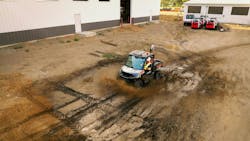What you'll learn
- Key features to consider in a compact utility vehicle.
- How to spec for durability and maintenance.
- Fuel options and environmental impact.
The evolution of the utility task vehicle (UTV) brought on new possibilities for a vehicle once thought of only for recreation. With their compact design, off-road mobility, and rugged durability, UTVs are engineered to traverse limited-access areas with efficiency and ease. Today, they can be found on any job site, and all-electric models hve expanded applications to more job sites and environments. With years of use within the rental, government and construction industries, work UTVs have proven their mastery in maximizing job site productivity. But don’t be fooled by a name; although work UTVs are capable, they are not all created equal. To make sure a UTV is the best fit for a fleet, it’s important to consider the environments of the job site, the scope of the work, and the features of the vehicle. —Here are key questions to ask in the acquisition process.
1. What is the towing, payload, and bed capacity?
Trucks have traditionally been the go-to solution for hauling and towing. Depending on the work requirements, however, a UTV may be all that’s needed, saving more expensive pickups from the wear and tear of driving around job sites. Compact utility vehicles are capable and enhance job site productivity by combining agility with their heavy-duty qualities. Features like high payload and towing allow these vehicles to transport materials, tools, and crew members more efficiently than traditional trucks, especially in tight spaces.
When adding a UTV to a construction fleet, it's important to consider the power, payload, and towing needed. Match the UTV’s payload and towing capabilities to job site needs.
2. Is the cab fully sealed to protect from rain or dust?
Vehicles with all-weather cabs, complete with heating and air conditioning, further increase efficiency by enabling work to continue comfortably and securely in changing temperatures and varied jobsite conditions.
3. How many people will it transport?
Options that fit crew size are just as important as meeting operational needs. Smaller or mid-size utility vehicles are typically designed for two to four passengers, making them a great choice for smaller teams or tasks where compact size and maneuverability are key. For larger teams, full-size UTVs that accommodate up to six passengers help the entire crew travel together efficiently.
4. Does a crew UTV that provides more passenger seating sacrifice cargo bed space?
Expanding to a utility vehicle with more passenger seating doesn’t have to mean sacrificing cargo space. Many crew models are designed to maintain sufficient cargo bed capacity, ensuring they can transport tools and materials without compromising productivity. This makes utility vehicles a versatile and practical solution for dynamic worksites.
5. Are the key components engineered to withstand the abuse of the job site?
Construction sites are notoriously harsh on vehicles, where efficiency is only as good as durability. Consider the job site conditions and elements, as well as the duration of work, so the vehicle can withstand the consistent wear and tear that comes with the territory.
Look for robust, heavy-duty components such as reinforced frames, sealed driveline systems, and job site-specific tires. For example, tires made from heavy-duty, nondirectional materials can better handle sharp debris and rugged terrain. Durable seating, such as Kevlar-backed vinyl, resists punctures and allows the cabin to remain functional despite demanding use. And sealed suspension systems and corrosion-resistant components protect the vehicle from dirt, dust, and moisture, reducing breakdowns. These features allow the vehicle to endure harsh conditions thrown at it without compromising performance.
6. How efficiently can routine maintenance checks be performed?
Routine maintenance maximizes UTV runtime. Maintenance can also prevent unexpected—and often lengthy—repairs that can lead to lost productivity. Features such as extended maintenance intervals, fault alarms, and universal parts can significantly reduce the time and resources required to keep the vehicle in optimal working condition.
Warning alarms for service needs—such as low oil pressure, belt slip, and engine overheating—allow operation to be paused before costly repair is needed and easy access points provide efficient maintenance checks.
Electric vehicles do not require engine oil changes, spark plugs, or clutch maintenance. Servicing is limited to essentials such as fluid changes for the transmission and front drive, as well as wear items like tires and brakes.
7. Are parts standardized?
When something does need replacing, UTVs that offer interchangeable nondirectional tires and universal parts are simple to replace for faster turnarounds. Minimal maintenance and easy upkeep mean fewer disruptions and a lower cost of ownership, maximizing job site productivity and fleet reliability.
8. What safety features are included and/or available?
Construction job sites aren’t without risk, making it crucial to prioritize processes, resources, and equipment that help reduce accidents and injuries, avoid mishaps, and enhance situational awareness. Operator alarms, for example, alert operators before they overuse the UTV, possibly causing damage.
Look for vehicles with standard safety components already built in, such as high-visibility, three-point seat belts, backup alarms and horns. These features will help increase operator awareness, while improving vehicle visibility. Built-in speed limiting provides adjustable driving speeds to help crew members continuously meet job site regulations. Depending on needs, UTVs can also be equipped with optional enhancements. For example, lightbars and side-view mirrors further help improve visibility and job site compliance, making it a practical choice for minimizing risk while maintaining productivity on demanding worksites.
9. What fuel will be on site?
There are UTV options to meet nearly every fuel requirement. Gas and diesel models are still the most common on construction sites, with many job sites equipped for fueling these traditional vehicles. Diesel-powered UTVs, known for their fuel efficiency and heavy-duty performance, are especially suited for long durations and high-demand tasks.
The demand for cleaner, more sustainable solutions, however, is growing across the construction industry, with more operations considering going electric. Electric UTVs (e-UTV) offer the same durability and efficiency as traditional gas-powered models while eliminating emissions, making them ideal for indoor environments or sites with strict environmental regulations. Additionally, e-UTVs offer quiet operation, minimal maintenance, and instant torque—with some models offering the same towing capacity as their gas counterparts. And with various battery options and capacities, e-UTVs can often run all day, minimizing downtime and meeting jobsite needs, and many can be charged with a standard 120V outlet, making them a viable option across job sites.
Selecting the right UTV for a construction fleet involves balancing durability, maintenance, and productivity needs with job site regulations. By prioritizing features that align with use case needs, job site requirements, and challenges, a UTV becomes a valuable asset that boosts performance and productivity while driving operation success. It might even replace the go-to pickup truck on job sites altogether.









